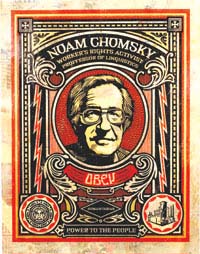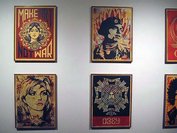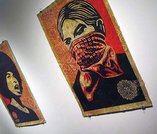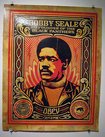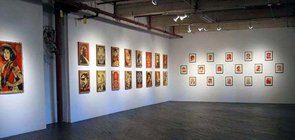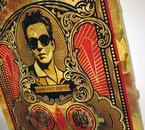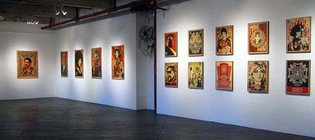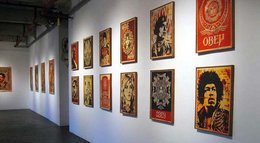Manufacturing Dissent (Black Floor Gallery) (Difference between revisions)
From The Giant: The Definitive Obey Giant Site
m |
|||
| Line 64: | Line 64: | ||
| [[Image:Black_Floor_picture_9.jpg|thumb|315px]] || [[Image:Black_Floor_picture_8.jpg|thumb|260px]] | | [[Image:Black_Floor_picture_9.jpg|thumb|315px]] || [[Image:Black_Floor_picture_8.jpg|thumb|260px]] | ||
|} | |} | ||
| + | |||
| + | Resources: | ||
| + | {| | ||
| + | [http://www.blackfloorgallery.com/site.php Black Floor Gallery] || [http://www.philadelphiaweekly.com/view.php?id=10926 Philadeplphia Weekly] || [http://www-us.flickr.com/photos/nespodzany/ Nespodzany] | ||
| + | |} | ||
| + | |||
| + | [[Category:TheGiant.Org]] | ||
| + | [[Category:Events]] | ||
Revision as of 04:52, 27 July 2006
Fully titled ""Manufacturing Dissent: New Works by Shepard Fairey", a Shepard Fairey show that took place at the Black Floor Gallery in Philadelphia from November 4, 2005 to November 26, 2005.
From Black Floor Gallery:
Artists Involved: Shepard Fairey
The term “Manufacturing Dissent” is a derivation of “the manufacturing of consent,” a phrase coined by Walter Lippmann to describe the propaganda engineering that he helped devise in order to drum up public support for World War I. Shepard Fairey designed his politically-charged pieces to counteract the hawkish manipulations of right-wing spin doctors with biting sarcasm and thought-provoking paradoxy. He juxtaposes symbols of combat with feminine imagery to expound upon his concept of powerful pacifism, the idea that force should be used as a means of protection rather than aggression. The explicit messages are a departure from Fairey’s deliberately ambiguous style. Rather than calling on people to question their surroundings, he asks them to fortify their values. While politicians and public relations gurus aim to skew reality into a more satisfying tune, Fairey strikes a dissonant chord, unusually lovely in its honesty.
“Manufacturing Dissent” will feature new works by Fairey including mixed media pieces, screen prints, spray paint stencils, and letterpress.
From Philadelphia Weekly:
The Good Shepard
The "André the Giant" guerrilla artist shows his collection of new works.
by Roberta Fallon
Admired for his trademark "André the Giant Has a Posse" and "Obey Giant" poster campaigns in cities around the world, Shepard Fairey is a counterculture guru whose message of peace, love and disobedience is as attractive to young people as the music of Jimi Hendrix. "He's a rock star to the youth," says Nick Paparone of Black Floor Gallery, which is showing new prints by the Los Angeles-based Fairey this month.
A solo show by an international art star is an ambitious push for the Black Floor collective, which took some financial risk (including insurance and shipping costs) to bring it in.
I got an advance peek at the prints on paper and wood, and was charmed. These are works quite unlike the "Obey Giant" posters and stickers which have a Western media-influenced feel with their high-contrast graphics and sans-serif typeface. The studio works, most dated 2005, have an old-fashioned socialist realist poster elegance instead, with baroque ornamentation and rich background designs suggestive of the patterning found in paper money.
The works-all of which use a strong central image of an iconic head-evoke everything from postage stamps, playing cards and cigar-box decor to antique revolutionary posters from the '60s and '70s. Fairey's poster children are counterculture heroes, from politicians and thinkers to rock stars: Lenin, Martin Luther King, Tupac, Noam Chomsky, Joe Strummer, Joey Ramone, Angela Davis, Jimi Hendrix, Slick Rick, Jam Master Jay, the young Johnny Cash, LL Cool J.
Fairey's message is one of antiwar and alternative capitalism. Resistance and respect are communicated through a worshipful treatment of the subjects, and lettered in words like "Peace," "Power to the People" and "Make Art Not War." It's an old message that's relevant to youth today.
In keeping with his street-side politics, Fairey is selling his posters at reasonable prices. Three large prints-the most ornate, beautiful and surprising-cost $2,000 each. Other works range in price, starting at an affordable $40. Most are signed and in numbered editions.
A series of 16 "Rubylith" images offer a sense of Fairey's work method. These red acetate film cutouts are a byproduct of the screenprint process-they're not prints themselves-and the framed, high-contrast Warholian images have no words or message.
Fairey, 35, runs a successful design business (Studio Number One) and the Subliminal Projects gallery in L.A.-where Space 1026 members Andrew Jeffrey Wright, Ben Woodward and Jim Houser had a show in 2004.
This is Fairey's second solo exhibit in Philadelphia. His first (in March 1999) was at Space 1026. He's currently in a residency program in Hawaii, but will try to make it to Philadelphia for his show, says Paparone. Let's hope he'll obey his instincts and come.
"Manufacturing Dissent: New Works by Shepard Fairey" Through Nov. 26. Black Floor Gallery, 319A N. 11th St., third fl. [1]
Pictures from ""Manufacturing Dissent: New Works by Shepard Fairey"
Resources:
